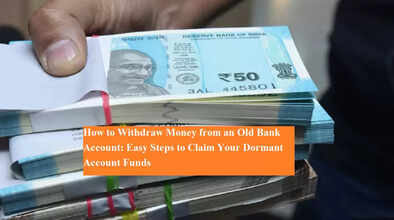How to Withdraw Money from an Old Bank Account: Easy Steps to Claim Your Dormant Account Funds

Have you left an old bank account unused for years and now discovered money stuck in it? Don’t worry — withdrawing funds from an inactive or dormant bank account is now simpler than ever. The Reserve Bank of India (RBI) has made the process more transparent, ensuring that no one loses their hard-earned savings due to inactivity.
When Does a Bank Account Become Dormant?
A bank account is classified as “dormant” or inactive if there has been no financial transaction (deposit or withdrawal) for two consecutive years. This includes savings, current, and fixed deposit accounts.
However, the good news is that even if your account becomes dormant, you or your legal heir can still claim the money at any time — including any interest accrued on the balance.
RBI’s Special Initiative for Unclaimed Deposits
To make the claim process easier, the Reserve Bank of India has launched a national outreach program to help citizens recover their unclaimed funds.
From October to December 2025, special Unclaimed Asset Camps are being organized in every district across India.
These camps will assist customers in tracing, verifying, and claiming deposits that have been transferred to the Depositor Education and Awareness (DEA) Fund — a fund managed by the RBI that holds money from inactive or unclaimed bank accounts.
Even if your account balance has been transferred to the DEA Fund, you still retain full ownership of the money and can claim it anytime.
How to Reactivate Your Account and Withdraw the Money
The procedure to withdraw funds from a dormant account is quick and simple. Follow these steps:
-
Visit Any Bank Branch
You don’t necessarily need to visit your original home branch. You can go to any nearby branch of the same bank to start the process. -
Fill Out a Reactivation Form
Ask for the account reactivation form and provide the required details such as account number, PAN, and address. -
Submit KYC Documents
You’ll need to submit valid KYC (Know Your Customer) documents such as Aadhaar Card, Passport, Voter ID, or Driving License to verify your identity. -
Verification by Bank Officials
Once you submit your application and documents, the bank will verify your details and revalidate your account. -
Receive Your Funds (With Interest)
After successful verification, your entire account balance — along with any applicable interest — will be credited back to your active account or issued to you as per your request.
No Penalty or Charges for Reactivation
According to RBI guidelines, banks cannot charge any fee or penalty for reactivating dormant accounts or processing claims for unclaimed deposits.
Customers have full rights to reclaim both the principal amount and interest, ensuring complete financial security.
Check Account Status and Unclaimed Deposits
Under the new rules, banks are now required to provide clear information about dormant accounts and unclaimed deposits on their official websites and at physical branches. Customers can easily check the status of their old accounts online before visiting a branch.
If your account appears as “inactive” or “dormant,” it’s best to act immediately to recover your money and update your records.
Why You Should Reactivate Old Accounts
Leaving old accounts unattended can lead to loss of interest income and even missed opportunities for financial growth. By reactivating your account:
-
You can consolidate your savings.
-
Avoid the hassle of documentation later.
-
Ensure your banking records remain updated.
-
Protect your funds from being transferred to the DEA Fund.
Bottom Line
With RBI’s transparent claim process and customer-friendly rules, recovering money from an old or dormant bank account is now completely hassle-free.
So, if you have funds stuck in an inactive account — whether it’s your own or a family member’s — don’t let it go unclaimed. Visit your nearest bank branch with the required KYC documents, complete the simple verification process, and get your money back — with interest.
Your savings are always safe — it just takes a few steps to bring them back to life.

